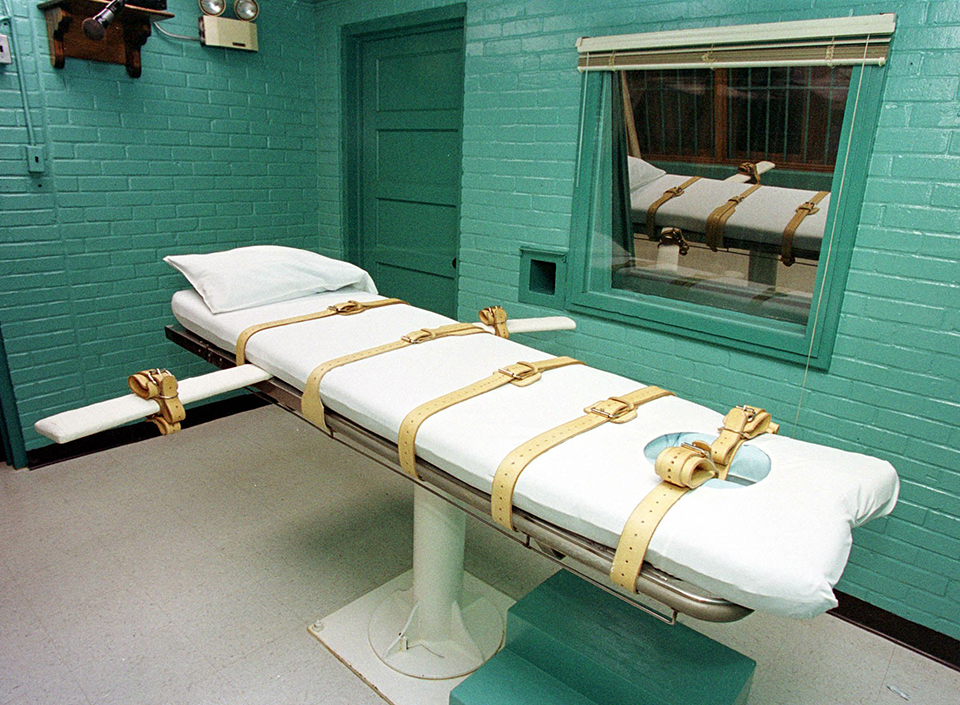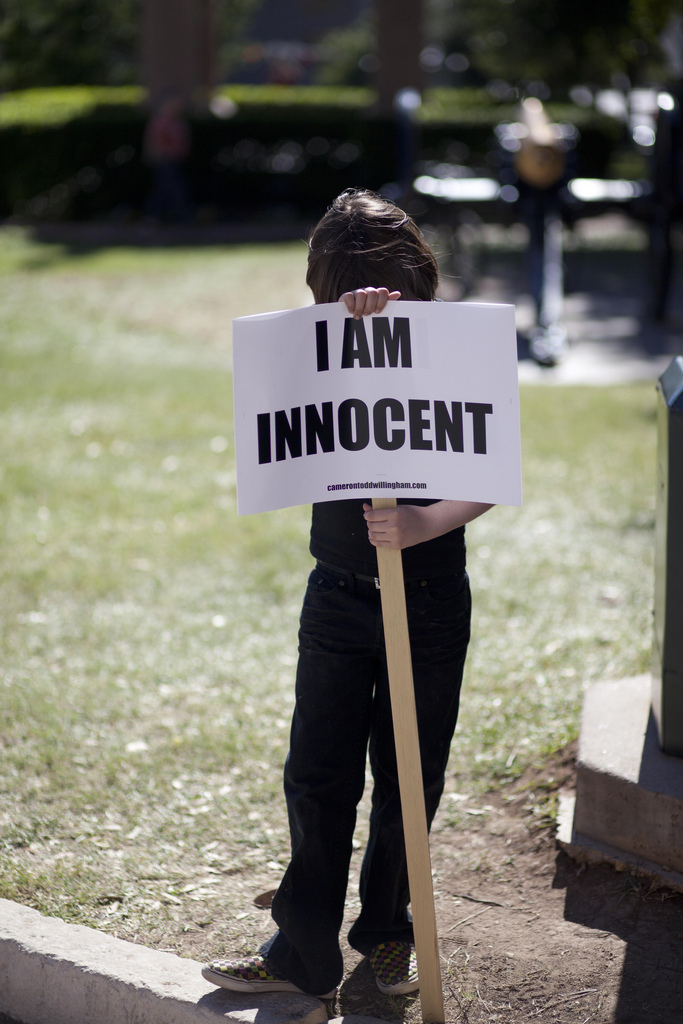Reginald Blanton’s mother, Anna Terrell, delivers powerful plea for the life of her son at a rally at the Texas Capitol on Sept 26, 2009. Reginald Blanton is scheduled to be executed in Texas on October 27, 2009. If you can not see the video below, click here to watch it on YouTube.
Medical Examiners Often Conduct Autopsies Carelessly, Resulting in Miscarriages of Justice
In the first of a multi-part series in the Fort Worth Star-Telegram, reporter Yamil Berard writes in “With little oversight in Texas, autopsies often careless” that lack of training and lack of oversight over Texas medical examiners who conduct autopsies creates a ripe situation for inaccurate forensic conclusions that can result in innocent people being convicted and even sent to death row.
Excerpt:
A woman was on her way to Death Row in Alabama after a medical examiner now working in Texas said she had suffocated her newborn. The sad truth, other experts said, was that the baby was stillborn.
An Austin baby sitter has spent years on Death Row for a baby’s murder. The medical examiner whose testimony helped put her there now says the baby’s death may have been an accident.
The medical examiner is the doctor-detective who is supposed to extract truth from the hodgepodge of details about a death. By examining body tissues, organs and fluids, gathering data from a crime scene and examining lab results, the medical examiner provides insight into how and why someone has died. Those judgments are of consequence for violent or suspicious deaths, as well as for unexplained deaths and those that might result from negligence or improper care.
County officials say the state’s system works well by unraveling questions surrounding death at a reasonable cost to taxpayers. In the courtroom, much of the work, they say, stands up to scrutiny.
But over the years, Texas medical examiners have misidentified bodies, botched examinations and had to do a double take on cases of individuals later exonerated by law enforcement. That has opened the door for innocent men and women to go to prison and killers to go free. The slapdash work of some medical examiners could also allow public health threats, wrongful deaths and preventable medical errors to go undetected, experts warn.
“The work of the medical examiner’s office is just so slipshod,” said Tommy Turner, the former special prosecutor who put a Lubbock medical examiner behind bars for falsifying autopsies.
Critics say the medical examiner’s office is “the last bastion of junk science.” The problems, they say, are similar to those that plagued the state’s crime labs for years: lack of performance standards, poor documentation, a shortage of qualified personnel and lax oversight.
“The state does not keep track of MEs in any shape, form or fashion,” Bexar County Chief Medical Examiner Randall Frost said. The state doesn’t even know how many certified forensic pathologists work in government offices, he added.
And a medical examiner doesn’t have to be trained in forensics or pass a specialty exam to do an autopsy. All that’s required is a state medical license. That’s akin to having your family doctor do brain surgery, says a growing chorus of medical examiners.
and
One significant weakness: Texas law doesn’t require medical examiners to take notes, produce body diagrams or photograph evidence.
Such documentation is essential, said Dr. Ray Fernandez, chief medical examiner for Nueces County. Without it, a medical examiner can’t back up an autopsy in court or show the validity of conclusions if challenged.
“A good report is based on how well that person documents their observations, so that another pathologist looking at the photographs, the diagrams, the report — looking at all of it — can at least assess the accuracy of what was done,” said Dr. LeRoy Riddick, a retired forensic pathologist who is a professor at the University of South Alabama. “The interpretations are something else.”
In one of the state’s most high-profile cases — the 1991 murders of four teenage girls at an Austin yogurt shop — pathologist Tommy Brown, who did the autopsies for Travis County, told jurors that he did not take crime scene photographs but relied on those taken by police.
He also said that “a lot of times” information he dictated didn’t get into his autopsy reports or he didn’t dictate information that should have been included. Two men convicted in the slayings, based largely on their confessions, were released this summer after new DNA tests showed that another man could have been involved.
Bayardo told the Star-Telegram that he never took notes because he feared they would be subpoenaed.
“That’s always a problem,” he said.
Instead, he would create an autopsy report by dictating information on tape.
In another case that drew in the Tarrant medical examiner’s office, capital murder charges against a young couple were dismissed two years after their baby’s death when some evidence apparently disappeared.
That case offered up a merry-go-round of opinions.
Bayardo declared the cause of death undetermined. Peerwani, who was asked for a separate opinion, released a report saying that the baby died of head trauma and that the case was a homicide.
Bayardo questioned how Peerwani — who didn’t examine the brain because it was apparently misplaced — came to that conclusion.
“How can you say she died of head injuries when you have no brain?” Bayardo said in a recent interview.
Peerwani has said he had slides with brain specimens and sent them to a specialist for review. The charges were dropped when the slides could not be found.
In a recent interview, Peerwani supported his preliminary finding of homicide: “A kid that little doesn’t have so many rib fractures.”
The Texas Medical Board did take action after whistle-blowers complained about former Harris County Medical Examiner Joye Carter. Initially, it sought to revoke or suspend her license after finding that she used an unlicensed pathologist to conduct hundreds of autopsies. Eventually, though, she was fined $1,000.
Questions about her work continued to be raised.
Numerous pathologists, including Dr. Lloyd White of the Tarrant County medical examiner’s office, have questioned Carter’s findings in the slaying of Conroe college student Melissa Trotter.
The time of the woman’s death was a critical piece of evidence. Carter said the young woman had been dead for 25 days or more when her body was found north of Houston. That helped persuade a jury to convict an ex-con. He could not have committed the crime if the woman had been dead a shorter time, because he was in jail for traffic violations.
But forensic pathologists testifying for the defense pointed to evidence that they said showed the body could not have been in the forest for more than two weeks. The young woman’s weight before she died was just 4 pounds more than when Carter performed the autopsy. Had Trotter been dead for 25 days, her body would have been in more advanced stages of decomposition and weighed much less, the pathologists said.
Dr. Glenn Larkin, a former medical examiner in Pennsylvania, also called Carter’s autopsy “sloppy,” “irresponsible” and “misleading,” noting that key medical records were missing and that some tissue samples had disappeared.
After the criticism, Carter signed an affidavit agreeing that Trotter could not have been dead for more than two weeks. She blamed problems on not having key evidence during the autopsy. A video of the crime scene and medical records were not available to her, she wrote.
Carter did not respond to repeated requests for comment.
The convicted man’s execution was postponed, but prosecutors are standing by Carter’s original autopsy report. The defense team, clamoring for the appeals court to intervene, points out that the state is rejecting opinions from some of the very pathologists prosecutors have relied on in other criminal cases.
“If all [these] medical examiners are all wrong on Melissa Trotter, how can they be right on all other cases?” said private criminal investigator Tina Church.
“There’s no room for error when somebody’s life depends on their findings.”
Dallas Morning News Editorial: Perry Ignoring Science
The Dallas Morning News has an editorial today responding to Governor Perry’s remarks this week on the Willingham case when he mocked the reports that a finding of arson in the Willingham fire could not be sustained by scientific analysis: “I’m familiar with the latter-day supposed experts on the arson side of it,” Perry said, making quotation marks with his fingers to underscore his skepticism. Even without proof that the fire was arson, he added, the court records he reviewed before the execution of Cameron Todd Willingham in 2004 showed “clear and compelling, overwhelming evidence that he was in fact the murderer of his children.”
So far, none of the candidates running to replace Perry as governor has made any public remarks on the Willingham case.
The editorial in the DMN points out that the public will have an opportunity to make public comments to the Texas Forensic Science Commission at their meeting next Friday, Oct 2 in Irving. Members of TMN and some of our friends plan to attend that meeting.
When a nationally respected fire engineer rebuked an arson investigation that sent a Texas man to his death, the country took notice.
The question of whether our state executed an innocent man spurred a national discussion, as media outlets from Nightline to The New Yorker explored whether the fiery deaths of Cameron Todd Willingham’s three young children were a tragic accident or capital murder. A growing number of experts have rejected the finding that the fire was arson, arguing that investigators relied on folklore and junk science to reach that unsupported conclusion.
Most recently, an expert hired by the Texas Forensic Science Commission issued a scathing report that detailed the many failings of the original arson-murder investigation. Dr. Craig L. Beyler wrote that investigators’ conclusions could not be supported by modern science.
Beyler’s emphatic rejection of the arson conclusion, coupled with similar findings by other forensic experts, have rightly compelled many to take a hard look at whether Texas got it wrong. On Friday, the Forensic Science Commission will take up Beyler’s report and decide how to proceed in this case.
But Gov. Rick Perry has not let expert reports or modern science shake his belief that Willingham must be a murderer. So certain is the governor that he’s delivered his own guilty verdict without bothering to wait for the Forensic Science Commission’s own conclusions in the case.
Perry flippantly dismissed the findings of “supposed experts.” Just in case his sarcasm wasn’t evident, he added air quotes with his fingers to dismiss the nationally respected scientists.
The governor says he’s seen nothing that would cause him to question this capital murder conviction. That’s disappointing.
While it’s difficult to say definitively whether a dead man was actually innocent, the prosecution’s original case appears to be unraveling. At the very least, Willingham would have sought a new trial and a chance to allow a jury to hear the more scientifically sound findings.
Prosecutors have said that other evidence – such as Willingham’s strange behavior at the time of the fire – proves his guilt. But if they could not credibly argue that this was arson, how did he kill his family?
The very foundation of this case has been debunked, so it requires a leap in logic to argue that without proof of arson, Willingham somehow still was guilty beyond a reasonable doubt.
Just as advances in DNA science have shed new light on physical evidence from old cases, improved scientific methods have helped experts understand how fire behaves and have provided new insights into arson investigations. To ignore these advances is irresponsible and risks the possibility of the state making a fatal error.
The governor would be wise to allow the commission to finish its work before making such definitive determinations. And as Perry considers this case, he should not allow reflexive certainty to trump science.Meeting this week
The Texas Forensic Science Commission will meet at 9:30 a.m. Friday at the Omni Mandalay Hotel at Las Colinas. On the agenda: a review and discussion of a new report that rebukes an arson investigation that led to Cameron Todd Willingham’s capital murder conviction. The meeting will include a public comment period.
Jeanette Popp, Mother of Murder Victim, to Speak at 10th Annual March to Abolish the Death Penalty
Jeanette Popp, mother of a murder victim, has agreed to come and speak at the 10th Annual March to Abolish the Death Penalty on October 24.
Jeanette published a new book this year called. Mortal Justice: A True Story of Murder and Vindication. It can be bought on Amazon.
Her book tells the story of her daughter Nancy’s murder, the wrongful conviction of two innocent men Chris Ochoa and Richard Danziger, their eventual exoneration, the subsequent conviction of the real killer, and Jeanette’s long activism against the death penalty, including a jailhouse meeting with the real killer and her successful efforts to prevent him from being sentenced to death.
In her new book, Jeanette includes an account of a jailhouse meeting with the man who actually killed her daughter before his trial because she wanted to convince him to take a plea bargain and accept life in prison istead of going to trial and risking the death penalty. In the jailhouse meeting, she told him, “Mr Marino, you know I don’t want you executed?”
“Ive heard that,” he answered stoically.
“It’s the truth. I don’t want you to die.”
He shook his head and told her, “Mrs Popp, I’d rather be executed than spend the rest of my life in prison.”
A recent Dallas Morning News article told Jeanette’s story:

Mother of ’88 murder victim says her faith in justice system shattered after exonerations
She thought justice served in daughter’s case, until exonerations
12:00 AM CST on Sunday, February 24, 2008
By DIANE JENNINGS / The Dallas Morning News
djennings@dallasnews.com
When Nancy DePriest was raped and murdered, her mother, Jeanette Popp, was sure the criminal justice system worked.
Now she’s sure it doesn’t.
“I don’t think we have learned anything,” she says almost 20 years later.
Ms. Popp, who now lives in Graham, Texas, sat in the courtroom day after day during the trial of Richard Danziger, who was accused of the sexual assault of her daughter. When Christopher Ochoa falsely confessed to the rape and killing and accused his friend in graphic testimony, “I had to leave the courtroom to throw up,” she says.
Mr. Ochoa “was so convincing,” she says, that she felt a twinge of sympathy for him because of his apparent remorse.
But Mr. Danziger glared at her during the trial and seemed to be “a bit of a smart aleck,” she says.
After the trial, she met with jurors.
“I hugged every one of them,” she says. “There wasn’t a dry eye in the place. … I couldn’t have thanked them any more for the justice they had given my child.
“I wouldn’t have questioned the police or the prosecution,” she says. And “the evidence was so overwhelming, so overwhelming.”
But on the 12th anniversary of her daughter’s death, she watched Travis County District Attorney Ronnie Earle say on TV that Mr. Ochoa and Mr. Danziger might be innocent. Another man, Achim Josef Marino, had confessed to the crime, and DNA evidence appeared to exonerate Mr. Ochoa and Mr. Danziger.
“My legs just gave way,” Ms. Popp says.
“I can’t do this again,” she remembers sobbing. “Please, God, don’t make me do this again.”
Prosecutors told her they had been trying for four years to tie all three men to the crime. But the Wisconsin Innocence Project showed there was no connection.When she realized Mr. Ochoa and Mr. Danziger were not guilty, her heart went out to their mothers.
“Chris’ mother and Richard’s mother lost their child for 12 years, as surely as I lost Nancy,” she thought.
She wrote to both men, telling them how sorry she was.
She says she never heard from Mr. Danziger, and when she learned he had been injured in a prison attack, “it almost killed me.”
She felt better when she received a letter from Mr. Ochoa.
“You have no business apologizing to me,” he wrote. “You didn’t do this to me, your family didn’t do this to me, your daughter didn’t.” He blamed police.
Ms. Popp says that at first, she wrestled with the pain Mr. Ochoa’s false confession caused her. “The horror that he made me believe my child went through gave me nightmares for 10 years,” she says.
She doesn’t understand why he confessed or, worse, “how he could have taken Richard with him.”
“I wasn’t in there,” she says. “So I honestly can say I don’t understand – but I forgive.”
When Mr. Ochoa was released in January 2001, Ms. Popp was in the courtroom with his mother. “My heart just filled with joy,” she says.
In a private moment, Mr. Ochoa told her he was “sorry I wasn’t strong enough to stand up to the police.” She took that as an apology.
Ms. Popp also met with Mr. Marino.
Facing the mother of the woman he killed was tough, Mr. Marino says. There wasn’t much he could say, so he kept it simple: “I’m sorry.”
But he refused her request that he plead guilty to avoid the strain of another trial. He pleaded not guilty by reason of insanity, was found guilty and received another life sentence.
Ms. Popp asked prosecutors not to seek the death penalty, because she says she did not want her daughter’s memory stained with someone’s blood. “I’m not a bleeding heart liberal,” she says. “But I do have a heart.”
Since the exoneration, she has been an outspoken opponent of the death penalty. That doesn’t mean she wants Mr. Marino to ever walk free.
“I’m a vengeful mother,” she says. “I want him to lay on that cot in his cell every night and wonder if somebody is going to come and rape him. I want him to stay in that Texas prison he hates so much.”
Execution Canceled for Thursday Sept 24 – Kenneth Mosley Gets Stay
Kenneth Mosley has received a stay of his execution that was scheduled for Thursday, Sept 24.
The U.S. Supreme Court Wednesday night stopped the scheduled execution of Texas death row inmate Kenneth Mosley a day before he was to receive lethal injection for the fatal shooting of a suburban Dallas police officer.
The court agreed to halt the lethal injection until it resolves an Alabama death penalty case that Mosley’s attorney said could affect his case.
The Alabama case, to be heard by the high court in November, centers on whether a trial lawyer was constitutionally deficient in failing to raise objections during the punishment phase of the trial.
Mosley’s attorneys have raised similar claims, saying his trial attorneys were deficient for not objecting to victim impact testimony from the officer’s wife and for not calling witnesses to testify about Mosley’s drug and alcohol addictions.
Mosley, 51, was condemned for the February 1997 shooting death of Garland Officer Michael David Moore. Moore was responding to a 911 call about a robbery at a bank.
One of four bullets to hit Moore struck over the top edge of his protective vest. Mosley was shot in the wrist by another officer waiting outside and was arrested in the parking lot. Authorities found he was carrying a holdup note.
“As far as him committing the actual crime, it was open and shut,” said Jason January, a former Dallas County assistant district attorney who prosecuted the case. “Plus we had a videotape of the event taking place and eyewitnesses.”
Mosley declined to speak with reporters in the weeks preceding his scheduled punishment. He had an extensive criminal record he blamed on drug addiction. Evidence at his trial showed he sexually assaulted a woman, was arrested for possession of marijuana and illegal knives, got busted for stealing merchandise from a Home Depot and then returning the items for cash refunds and for robbing a Home Depot.
At the time of the shooting, he was wanted for a fast-food restaurant robbery five days earlier in nearby Mesquite and had been fired from his last known job at a Coca-Cola bottler for testing positive for cocaine.
Jurors who decided the Flint, Mich., native should be given the death penalty also heard how he told deputies guarding him during his capital murder trial that it would “make his day to kill another cop,” according to court documents.
Mosley’s trial lawyers didn’t deny the shooting but argued it was accidental, that as he was trying to surrender the weapon it went off five times.
Moore was 32, married and the father of three. He went to high school in Middletown, Ohio, served four years in the Marines and in 1987 joined the Garland police force. He’d won numerous awards and commendations during his 10 years on the job.
Tuesday evening, Christopher Coleman, 37, was put to death for the slayings of three people in a Houston drug deal robbery. Next week, John Balentine, 40, faces lethal injection for the slayings of three teenagers at a house in Amarillo in January 1998.
- Texas Moratorium Network (TMN) is a non-profit organization with the primary goal of mobilizing statewide support for a moratorium on executions in Texas. Significant death penalty reform in Texas, including a moratorium on executions, is a viable goal if the public is educated on the death penalty system and is encouraged to contact their elected representatives to urge passage of moratorium legislation.
We hope that you will join us in this fight for fairness and social justice.Please join our email list and become one of the more than 20,000 people receiving information through our network.










